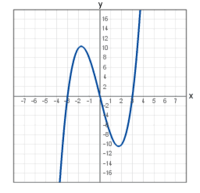Closed graph theorem
In mathematics, the closed graph theorem is a basic result which characterizes continuous functions in terms of their graphs. There are several versions of the theorem.
Contents
The closed graph theorem[edit]
In mathematics, there are several results known as the "closed graph theorem".
In point-set topology[edit]
For any function T : X → Y, we define the graph of T to be the set
In point-set topology, the closed graph theorem states the following: If X is a topological space and Y is a compact Hausdorff space, then the graph of T is closed if and only if T is continuous.[1]
In functional analysis[edit]
In functional analysis, the closed graph theorem states the following: If X and Y are Banach spaces, and T : X → Y is a linear operator, then T is continuous if and only if its graph is closed in X × Y (with the product topology).
In the latter case we say that T is a closed operator. Note that the operator is required to be everywhere-defined, i.e., the domain D(T) of T is X. This condition is necessary, as there exist closed linear operators that are unbounded (not continuous); a prototypical example is provided by the derivative operator on C([0,1]) (whose domain is a strict subset of C([0,1])).
The usual proof of the closed graph theorem employs the open mapping theorem. In fact, the closed graph theorem, the open mapping theorem and the bounded inverse theorem are all equivalent. This equivalence also serves to demonstrate the necessity of X and Y being Banach; one can construct linear maps that have unbounded inverses in this setting, for example, by using either continuous functions with compact support or by using sequences with finitely many non-zero terms along with the supremum norm.
The closed graph theorem can be reformulated as follows. If T : X → Y is a linear operator between Banach spaces, then the following are equivalent:
- For every sequence {xn} in X, if the sequence {xn} converges in X to some element x, then the sequence {T(xn)} in Y also converges, and its limit is T(x).
- For every sequence {xn} in X, if the sequence {xn} converges in X to some element x and the sequence {T(xn)} in Y converges to some element y, then y = T(x).
Generalization[edit]
The closed graph theorem can be generalized to more abstract topological vector spaces in the following ways:
- A linear operator from a barrelled space X to a Fréchet space Y is continuous if and only if its graph is closed in the space X×Y equipped with the product topology.
and there is a version that does not require Y to be locally convex:[2]
- If the graph of a linear map between two F-spaces is closed then the map is continuous.
and an even more general version of the closed graph theorem is[3]
- Suppose that X and Y are two topological vector spaces (they need not be Hausdorff or locally convex) with the following property: If G is any closed subspace of and u is any continuous map of G onto X, then u is an open mapping. Under this condition, if is a linear map whose graph is closed then f is continuous.
The Borel Graph Theorem[edit]
The Borel graph theorem, proved by L. Schwartz, shows that the closed graph theorem is valid for linear maps defined on and valued in most spaces encountered in Analysis.[4] Recall that a topological space is called a Polish space if it is a separable complete metrizable space and that a Souslin space is the continuous image of a Polish space. The weak dual of a separable Fréchet space and the strong dual of a separable Fréchet-Montel space are Souslin spaces. Also, the space of distributions and all Lp-spaces over open subsets of Euclidean space as well as many other spaces that occur in analysis are Souslin spaces. The Borel graph theorem states:[5]
- Let X and Y be locally convex Hausdorff spaces and let be linear. If X is the inductive limit of an arbitrary family of Banach spaces, if Y is a Souslin space, and if the graph of u is a Borel set in , then u is continuous.
An improvement upon this theorem, proved by A. Martineau, uses K-analytic spaces. A topological space X is called a if it is the countable intersection of countable unions of compact sets. A Hausdorff topological space Y is called K-analytic if it is the continuous image of a space (that is, if there is a space X and a continuous map of X onto Y). Every compact set is K-analytic so that there are non-separable K-analytic spaces. Also, every Polish, Souslin, and reflexive Frechet space is K-analytic as is the weak dual of a Frechet space. The generalized theorem states:[6]
- Let X and Y be locally convex Hausdorff spaces and let be linear. If X is the inductive limit of an arbitrary family of Banach spaces, if Y is a K-analytic space, and if the graph of u is closed in , then u is continuous.
See also[edit]
Notes[edit]
- ^ Munkres (2000), p. 171
- ^ Trèves (1995), p. 173
- ^ Treves p. 169
- ^ Treves p. 549
- ^ Treves p. 549
- ^ Treves pp. 557-558
References[edit]
- Munkres, James (2000), Topology (2nd ed.), Upper Saddle River: Prentice Hall, pp. 163–172, ISBN 0-13-181629-2
- Trèves, François (1995), Topological Vector Spaces, Distributions and Kernels, Academic Press, Inc., pp. 169–173, 549–557, ISBN 0-486-45352-9
- Folland, Gerald B. (1984), Real Analysis: Modern Techniques and Their Applications (1st ed.), John Wiley & Sons, ISBN 978-0-471-80958-6
- Rudin, Walter (1973), Functional analysis, Tata MacGraw-Hill.
- "Proof of closed graph theorem". PlanetMath.






